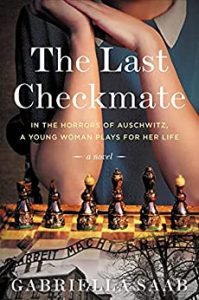Fearing—and Embracing—the Process By Gabriella Saab
 Writing historical fiction is a complicated and extensive process, one that terrified me because I loved this genre and dreamed of writing it. But how could I possibly write a book and do so much research?! Then an idea came to me, persistent and relentless: In the scene was Maximilian Kolbe, a Franciscan friar and priest who was imprisoned in Auschwitz in 1941. With him was another inmate—a girl who clung to his comforting presence. In 1941, Auschwitz was a prison camp for men only, so I asked myself if this girl had been sent to Auschwitz during this time, why might she have been imprisoned rather than executed? What might she have done to fight for survival?
Writing historical fiction is a complicated and extensive process, one that terrified me because I loved this genre and dreamed of writing it. But how could I possibly write a book and do so much research?! Then an idea came to me, persistent and relentless: In the scene was Maximilian Kolbe, a Franciscan friar and priest who was imprisoned in Auschwitz in 1941. With him was another inmate—a girl who clung to his comforting presence. In 1941, Auschwitz was a prison camp for men only, so I asked myself if this girl had been sent to Auschwitz during this time, why might she have been imprisoned rather than executed? What might she have done to fight for survival?
To answer that question, I had to face my fear. I had to write a historical novel. And so began my research for the book that became my debut, The Last Checkmate.
With so much information available on World War II, I had to be intentional about my research, determining what was relevant and necessary to build my plot and what was not. In doing so, I concentrated on three main historical elements: the Polish resistance movement, the camp resistance movement in Auschwitz, and the Women’s Orchestra in Auschwitz. These women were forced to play music both to entertain their SS captors and to accompany psychologically tormenting moments in prisoners’ lives, such as executions. My main character, Maria, a Polish Catholic resistance member from Warsaw, is caught and sent to Auschwitz, where she is forced to utilize her chess skills to entertain the guards, knowing she will be executed when the camp deputy, Fritzsch, no longer finds her useful.
In April 1945, Maria, on a quest for justice, returns to Auschwitz to confront Fritzsch over a final chess game. The story moves back and forth from this confrontation to Maria’s work for the Polish resistance, beginning in 1941, and her time in Auschwitz. This might seem like a complicated way to write a book—to an extent, it was—but this is where my process saved me from what might have been a huge headache.
I’m what we writers call a plotter: I take notes on my research, develop character arcs and themes, write a full plot summary, and break all of that down into a detailed, chapter-by-chapter outline. Only then do I start writing. It’s like if you plug a route into your phone and zoom out to view the full map, or pull up the step-by-step directions: you see the whole picture—every turn, every change in direction, until you reach your destination. This process is my road map. Since I knew where my story’s breaks and shifts and changes were ahead of time, structuring the novel in this way wasn’t as difficult as it might have been.
As one might imagine, this story required harrowing research, so I would be remiss to leave out one vital step of my process: self-care. To understand Maria’s experiences and portray them and their impacts on her mental health as realistically as possible, I spent a lot of time listening to survivor testimonies, looking at images of Auschwitz and its victims, and immersing myself in what so many real people went through. An experience rife with suffering, torture, sickness, pain, and death. Since I spent so much time with this subject matter, either through research or through writing a main character who is living these experiences, I made it a priority to care for myself while doing so. I read lighthearted fiction, watched sitcoms, worked out, and stepped away when necessary.
For my day-to-day process: my schedule is inconsistent. I teach fitness classes at various times, so writing gets done in snatches of time between, before, after, or on weekends. But if I have a day dedicated to writing, I usually get started by 9am—I’m a night owl, so any earlier than that and my brain isn’t functioning yet. I have coffee and breakfast, check emails, social media, and other quick tasks, then start writing.
If I’m drafting, I edit what I wrote the day before—which helps me clean up the previous day’s work and grounds me back into the story—then I write until the words stop coming. I write at my desk with coffee or Diet Coke nearby, breaking for lunch, snacks, or to take my dog out. I try to end my day at a normal time, but when I get deep into a story, it’s all I want to do and all I think about, so that often makes for a work/life balance that probably isn’t the healthiest! If I’m on a roll like that, sometimes I’ll be working into the wee hours of the morning.
I’m sure my writing process will evolve as I do and as each story presents new challenges—after all, no two books are the same—though I know for a fact that I’ll always be a plotter. Some things never change! I’m so glad I mustered up the courage to attempt historical fiction; if I hadn’t, I’m not sure where I would be today. The task can be daunting, true, but it gives me the opportunity to bring little-known stories and nuggets of history to life. Each day is an exciting new challenge, one I’m honored to undertake.
—
>Author bio: Gabriella Saab graduated from Mississippi State University with a bachelor of business administration in marketing and now lives in her hometown of Mobile, Alabama, where she works as a barre instructor. While researching The Last Checkmate, she traveled to Warsaw and Auschwitz to dig deeper into the setting and the experiences of those who lived there. The Last Checkmate is her first novel.
Social media:
Website: https://
Facebook: https://www.facebook.com/
Twitter: @GabriellaSaab_
Instagram: @GabriellaSaab_
THE LAST CHECKMATE
 A PopSugar Best Book of the Year!
A PopSugar Best Book of the Year!
Readers of Heather Morris’s The Tattooist of Auschwitz and watchers of The Queen’s Gambit won’t want to miss this amazing debut set during World War II. A young Polish resistance worker, imprisoned in Auschwitz as a political prisoner, plays chess in exchange for her life, and in doing so fights to bring the man who destroyed her family to justice.
Maria Florkowska is many things: daughter, avid chess player, and, as a member of the Polish underground resistance in Nazi-occupied Warsaw, a young woman brave beyond her years. Captured by the Gestapo, she is imprisoned in Auschwitz, but while her family is sent to their deaths, she is spared. Realizing her ability to play chess, the sadistic camp deputy, Karl Fritzsch, decides to use her as a chess opponent to entertain the camp guards. However, once he tires of exploiting her skills, he has every intention of killing her.
Befriended by a Catholic priest, Maria attempts to overcome her grief, vows to avenge the murder of her family, and plays for her life. For four grueling years, her strategy is simple: Live. Fight. Survive. By cleverly provoking Fritzsch’s volatile nature in front of his superiors, Maria intends to orchestrate his downfall. Only then will she have a chance to evade the fate awaiting her and see him punished for his wickedness.
As she carries out her plan and the war nears its end, she challenges her former nemesis to one final game, certain to end in life or death, in failure or justice. If Maria can bear to face Fritzsch—and her past—one last time.
BUY HERE
Category: On Writing






























